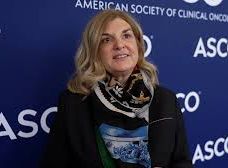- Center on Health Equity & Access
- Clinical
- Health Care Cost
- Health Care Delivery
- Insurance
- Policy
- Technology
- Value-Based Care
ASCO 2024 New & Emerging Therapies
New FDA Approvals: ASCO Session Reviews Uses and Adverse Effects
What should doctors expect if they prescribe nirogacestat for desmoid tumors? What about fruquintinib for metastatic colorectal cancer (mCRC)?
Nirogacestat (Ogsiveo; Springworks Therapeutics) and fruquintinib (Fruzaqla; Takeda Pharmaceuticals) were among the therapies featured in the annual session on newly approved drugs, which took place on the first day of the 2024 American Society of Clinical Oncology (ASCO) Annual Meeting.
Mrinal M. Gounder, MD | Image: Memorial Sloan Kettering Cancer Center

Mrinal M. Gounder, MD, medical oncologist at Memorial Sloan Kettering Cancer Center, offered an overview of desmoid tumors, which are fibrous growths that emerge in connective tissue, typically in young adults. The tumors can appear in many areas of the body but most often are found in the abdomen. The experience can be extremely painful and isolating for patients, Gounder said, and he encouraged clinicians to help patients find support groups.
“Since very few patients die of this disease, it’s very important to evaluate whether a drug actually improves their quality of life,” Gounder said. Sometimes tumors spontaneously regress for reasons not well understood.
Enter nirogacestat, approved November 27, 2023.1 This oral γ-secretase inhibitor is the first systemic treatment approved specifically for desmoid tumors, based on a phase 3 study that evaluated patients whose tumors had progressed within 12 months of screening. Results showed significant improvement in progression-free survival (PFS) compared with placebo, with an HR of 0.29.1
“It was highly statistically significant,” Gounder said. There were PFS benefits among many subgroups, including patients with prior chemotherapy. The study showed responses in the placebo arm as well, “reinforcing that an initial period of observation is appropriate ina selected group of patients with this disease,” Gounder said.
Giving patients nirogacestat means managing adverse effects, including diarrhea, nausea, and fatigue that are associated with the drug class. Some patients experience a rash or a postnasal drip. In the phase 3 study, Gounder said, 42% of patients had dose reductions and 20% discontinued treatment.
A more serious adverse event “is ovarian toxicity, which was observed in 75% of women of childbearing potential,” Gounder said. “As I mentioned before, most of the population that [develops] desmoid tumors are really young people in their 20s and 30s,” and there is “a slight preponderance for women.”
He described ovarian toxicity as a decrease in several specific female reproductive hormone levels; thus, female patients should have baseline levels recorded before treatment. Gounder said he also refers female patients to a fertility preservation specialist. On the plus side, he said, “what’s important is that…78% of patients had resolution of this ovarian toxicity.”
“This drug is effective in first or subsequent lines of therapy,” Gounder said. Diarrhea, skin rashes, and nasal congestion are transitory and can be addressed by temporarily holding the drug or adjusting the dose “as necessary to maintain the quality of life of these patients. And ovarian toxicities genuinely have been reversible,” he said.
Fruquintinib for mCRC
Cathy Eng, MD, FACP, FASCO, professor of medicine, hematology, and oncology, codirector of gastrointestinal (GI) oncology and coleader of the GI Cancer Research Program at Vanderbilt-Ingram Cancer Center, reviewed the approval for fruquintinib, which came on November 8, 2023.2 This inhibitor of VEGFR-1, -2, and -3 is approved for third-line treatment or beyond for patients with mCRC who have received prior treatment with fluoropyrimidine, oxaliplatin, and irinotecanbased chemotherapy, an anti-VEGF therapy, and, if RAS wildtype and medically appropriate, an anti-EGFR therapy.
Cathy Eng, MD, FACP, FASCO | Image: Vanderbilt-Ingram Cancer Center

Fruquintinib addressed a significant medical need in mCRC. “As many of you know, for our surgically unresectable patients, the 5-year survival for these patients is 15%,” said Eng, who was the co–senior author for FRESCO-2, 1 of 2 trials that led to the approval.2 The primary end point for FRESCO-2 was overall survival (OS), which had an HR of 0.66; the median OS for fruquintinib was 7.4 months compared with 4.8 months for placebo. FRESCO, conducted in China, had a similar HR of 0.65; in this trial, Eng said, OS was 9.3 months for fruquintinib and 6.57 months for placebo. PFS for FRESCO-2, the key secondary end point, was 3.7 months for fruquintinib vs 1.8 months for placebo, for a difference of 1.9 months, Eng said during the session.2
“The mechanism of action for this selective inhibitor of VEGF inhibitors impacts angiogenesis,” which affects tumor growth, she said. Common adverse effects include hypertension—which is a class effect—anemia, and hand and foot skin reactions.
“In China, they noted a fairly high incidence of hypertension [at] grade 3 for about 21% of patients and hand-foot skin reaction in about 11% of patients,” Eng said. The hypertension incidence was not as high in FRESCO-2; about 14% of patients reported it, and a smaller share of patients had anemia and skin reactions. Said Eng, “24% of patients required dose reductions—similar to FRESCO.”
“We also looked at health-related quality of life,” she said, and time to deterioration was either in favor of fruquintinib or equivalent, “but no worse.”
Real-world experience. “How do we apply this to the patient population?” Eng asked. She shared a case of a 56-year-old woman with surgically unresectable, microsatellite-stable mCRC who had been previously treated with FOLFOX (fluorouracil, leucovorin calcium, oxaliplatin) plus bevacizumab. No clinical trial was available for the patient.
The woman “informs me she travels for work and would like some increased convenience.” Eng displayed information for different treatment options, adding, “I show you this data here not for cross-trial comparisons per se, but really to look at the toxicities of therapy that may potentially occur with your patient, because this is what we do in real life.”
For Eng’s patient, fruquintinib offered a choice that would be least disruptive. The patient did experience some discomfort in her thumb and her foot; she delayed treatment for a week but resumed therapy with no residual issues. “After much discussion, we offer shared decision-making and she opted not to decrease her dose—she feels rather well,” with CT scans set for July 2024.
Belzutifan in Advanced Renal Cell Carcinoma
Eric Jonasch, MD, professor, Department of Genitourinary Medical Oncology, The University of Texas MD Anderson Cancer Center, discussed belzutifan, approved as Welireg (Merck) on December 14, 2023, in renal cell carcinoma (RCC).3 This oral drug, an HIF-2α inhibitor, is administered once a day and was previously approved for patients with Von Hippel–Landau (VHL) disease–associated RCC.
As Jonasch explained, belzutifan is approved for patients with RCC after progression on an immune checkpoint inhibitor and a tyrosine kinase inhibitor. Results from the phase 3 trial showed that “tumor reduction or stabilization occurred in about two-thirds of individuals,” and compared with everolimus (Afinitor; Novartis), there was an improved response rate duration of response.
“We do see that this drug has not only novel mechanism of action, but novel-ish [adverse] effects, including anemia, hypoxia, and fatigue,” he said. Recommendations, which include monthly monitoring of hemoglobin, self-monitoring of oxygen saturation and appropriate dose adjustments and interventions, “are going to optimize the quality of life for these individuals receiving this therapy.”
Jonasch outlined belzutifan’s mechanism of action in detail, explaining the activity of HIF-2α especially if there is deficiency in VHL; the “unbridled” levels of HIF-2α must then be reined in to prevent the growth of VHL-associated tumors. Belzutifan blocks HIF-2α from interacting with other proteins that would allow tumor growth.
He outlined a case of a 64-year-old woman with metastatic clear cell RCC who developed metastatic disease 18 months after nephrectomy. Two separate lines of treatment, including immunotherapy, produced initial improvement, followed by progression in the form of lung lesions.
“How do you treat? Looking at the [National Comprehensive Cancer Network] guidelines, we have a little bit of a conundrum here. And for those who are familiar with the NCCN [National Comprehensive Cancer Network] guidelines for renal cell carcinoma in subsequent lines of therapy, we don’t have preferred agents—we have other recommended agents, because there are few trials that really have been done in this setting of post [-immuno-oncology]. Most of the registrational studies have been both been done post TKI [tyrosine kinase inhibitors]. So, we’re tempering our enthusiasm somewhat for the agents.”
What of the patient? She noticed a change in her oxygen saturation, which went from baseline mid-90s to high 80s. With a dose reduction to 80 mg, her oxygen saturation returned to above 90%.
Understanding progress with this therapy can be challenging. “Unlike TKI, where we see most of the benefit occurring in the first 1 or 2 scans, we see a linear continuous improvement and those individuals who do have a decrease in the disease size. At this point in time her hemoglobin has dropped below 10 and after discussion with the patient about the risks and benefits of either not doing anything, dose-reducing transfusions, or giving exogenous erythropoietin, she chooses to receive a darbepoetin (alfa) injection.”
The patient had a partial response at the next restaging. Although it’s not specific, Jonasch said, “I would not recommend you use this for non–clear cell RCC after progression on an [immune checkpoint inhibitor] and a TKI on tumor reduction. Stabilization occurred in about two-thirds of individuals, and we do see that if a response occurs, it’s fairly durable.”
References
1. FDA approves nirogacestat for desmoid tumors. FDA newsroom. Updated November 28, 2023. Accessed June 1, 2024. https://www.fda.gov/drugs/resources-information-approved-drugs/fda-approves-nirogacestat-desmoid-tumors
2. FDA DISCO burst edition: FDA approval of Fruzaqla (fruquintinib) in adult patients with metastatic colorectal cancer. FDA newsroom. January 5, 2024. Accessed June 1, 2024. https://www.fda.gov/drugs/resources-information-approved-drugs/fda-disco-burst-edition-fda-approval-fruzaqla-fruquintinib-adult-patients-metastatic-colorectal
3. FDA approves belzutifan in advanced renal cell carcinoma. FDA newsroom. Updated December 14, 2023. Accessed June 1, 2024. https://www.fda.gov/drugs/resources-information-approved-drugs/fda-approves-belzutifan-advanced-renal-cell-carcinoma
ADC Improvements Mean More Targets, New Questions About Sequencing
Updates about antibody-drug conjugates (ADCs) were coming so fast at the 2024 American Society of Clinical Oncology (ASCO) Annual Meeting that Sarah Cannon Research Institute’s Erika P. Hamilton, MD, included a “breaking news” slide in her opening presentation at the June 2 session, “Next-Generation Antibody-Drug Conjugates: The Revolution Continues.”1
The results, presented the day prior, were from a trial (NCT04225117) that evaluated enfortumab vedotin (Padcev; Astellas Pharma US, Inc/Seagen Inc), a Nectin-4–directed ADC, in metastatic hormone receptor–positive (HR+)/HER2– and triple-negative breast cancer (TNBC).2
Erika Hamilton, MD | Image: Sarah Cannon Research Institute

But then Hamilton, the director of breast cancer and gynecologic cancer research at Sarah Cannon Research Institute, had one more tweak: She added results for the phase 3 DESTINY-Breast06 trial (NCT04494425), which were just 2 hours old. They involved trastuzumab deruxtecan (Enhertu; AstraZeneca/ Daiichi Sankyo), which showed statistically significant improvements in progression-free survival (PFS) compared with chemotherapy in patients with HR+/HER2-low and HER2-ultralow breast cancer.3
Together, both sets of trial findings highlighted key points from Hamilton’s remarks: The enfortumab vedotin data showed similar PFS regardless of prior treatment with sacituzumab govitecan (Trodelvy; Gilead Sciences, Inc), which has important implications for sequencing therapeutic options. Additionally, the DESTINY-Breast06 results show that in the generation since the first ADCs arrived in 2000, improvements in their “linker” technology mean a broader spectrum of patients can receive these drugs.
“ADCs are really revolutionizing cancer therapeutics across both solid and liquid tumors,” Hamilton said. “They provide an advantage over traditional cytotoxic chemotherapy in terms of [adverse] effects. They’ve evolved from targeting only high antigen expression now, in fact, to most not needing to test expression.”
However, she said, “We still have a lot of questions around resistance and sequencing.”
Hamilton explained that a critical variable in these therapies is the drug to antibody ratio, or DAR. Newer ADCs, such as sacituzumab govitecan and trastuzumab deruxtecan, have a cleavable linker and a higher DAR. “You really see an explosion of these approved agents around 2019, with 6 approved in solid tumors and 6 approved in hematologic malignancies,” she said.
Although the basic elements of ADCs are the same across therapies, there are differences in payload and adverse events (AEs), and some still require target expression for activity. As a group, ADCs offer a powerful attack on their target with more limited AEs than traditional chemotherapy.
However, “Toxicities are not a class effect,” Hamilton noted. “ADCs certainly minimize systemic toxicity compared with chemotherapy, yet they’re all associated with unique [adverse] effects.”
She noted the ocular effects of some drugs, such as mirvetuximab soravtansine (Elahere, ImmunoGen), which is approved to treat platinum-resistant ovarian cancer.4 Nausea is seen in trastuzumab deruxtecan, “and then we have quite a few [drugs] that have hematologic toxicity.”
The use of ADCs in community settings, she said, will “require recognition of the unique [adverse] effects of each agent, so we can help with supportive care medications and prophylactic medications for our patients, so they can best tolerate these drugs.”
Hamilton led the audience through a discussion of mechanisms of resistance, noting that clinicians will face target options and choices—with the prospect of bispecific ADCs and dual targets becoming available. “We are still in the infancy of understanding resistance and how best to sequence. Understanding when and if expression matters is integral, and novel targets and payloads will probably be key to allow meaningful sequencing.”
Patient Perspective. Sabrina Mayhew, PhD, RN, CN-BN, of the Quantum Leap Healthcare Collaborative, shared her thoughts on the “excitement and anticipation” that ADCs have generated among patients and the public. However, she cautioned that descriptions of the “acceptable” or “manageable” safety profile in abstracts can still substantially impact the quality of life. “While the symptoms may not be life-threatening, they can still impair daily functioning and diminish overall well-being.”
Financial burdens can be significant, too. “Patients face large out-of-pocket costs, including premiums for insurance coverage. The financial strain often forces patients to make difficult decisions between prioritizing their health care needs or meeting other essential expenses such as rent or groceries.” Regulatory agencies often do not ask about this, Mayhew said, and researchers should.
Finally, access is an issue. “Some ADCs are only available through a clinical trial,” and patients must meet specific criteria. Involving the advocate’s perspective earlier in the process would help researchers ensure “that their work remains patient centered.”
“Ultimately, the goal of treatment is to prolong survival while optimizing the quality of life, allowing patients to not only survive but thrive and enjoy meaningful experiences during their lifetime,” Mayhew said. “Getting treatments faster [is] only useful if they really help people and do not cause harm.”
Solid Tumor Trials: LUMINOSITY and OPTITrop-Breast01
David Ross Camidge, MD, PhD, of the University of Colorado Cancer Center then presented the primary analysis results for the phase 2 LUMINOSITY trial (NCT03539536) evaluating “telisotuzumab vedotin monotherapy for patients with previously treat[ed] c-MET overexpressing nonsquamous EGFR wild-type advanced non-small cell lung cancer [NSCLC].”5
David Ross Camidge, MD | Image: University of Colorado

Known as Teliso-V, this ADC is a first-in-class therapy directed against surface c-MET expression, seen in about 25% of patients with EGFR wild-type NSCLC. Patients had locally advanced or metastatic c-MET overexpressed disease and had received at least 2 prior lines of therapy, including chemotherapy, immunotherapy (I/O), or sequential chemotherapy and I/O. The primary end point was overall response rate (ORR). Results showed the following:
- 172 patients received at least 1 dose of Teliso-V and made up the safety population.
- 161 patients (78, c-MET high; 83, c-MET intermediate) were included in the baseline and efficacy analyses.
- Median age, 64 years; 69% of patients were male; 70% had ECOG performance status 1
- 97.5% had received prior platinum chemotherapy; 82.0% had received prior immune checkpoint inhibitors.
- ORR was 34.6%, c-MET high; 22.9%, c-MET intermediate; 28.6%, overall
Median duration of response (DOR) was 9.0 months, c-MET high; 7.2 months, c-MET intermediate; 8.3 months, overall - Treatment-related AEs (TRAEs): peripheral neuropathy, 30%; peripheral edema, 16%; fatigue, 14%. Two patients died from interstitial lung disease (ILD) and respiratory failure.
Camidge noted that 9% of patients stopped therapy due to ILD, with the median time to stopping being 48 days. “In contrast, 10% discontinued for peripheral neuropathy, with the median time to discontinuation being 222.5 days, suggesting this reflects a cumulative exposure,” he said.
With the higher MET protein levels associated with higher response rates, “additional analyses of protein expression overlapping with MET genetic abnormalities—for example, mutations or amplifications—are ongoing.”
Next, Binghe Xu, MD, PhD, of National Cancer Center/Cancer Hospital, Chinese Academy of Medical Sciences, presented results from OPTITrop-Breast01, evaluating sacituzumab tirumotecan (sac-TMT) in patients with previously treated locally recurrent or metastatic TNBC (NCT05347134).6 Merck has licensed the ADC from Sichuan Kelun-Biotech Pharmaceutical Co, Ltd.
According to the abstract, the therapy has a novel linker to conjugate with the payload, a belotecan-derivative topoisomerase I inhibitor with a DAR of 7.4, and the linker design enables the bystander effect. The phase 3 study compared sac-TMT (n = 130) with physician’s choice of chemotherapy (n = 133). Per the abstract, results were as follows:
- Patients’ median age was 51 years; 87% had visceral metastases.
26% had received prior PD-1/PD-L1 inhibitors; 48% had received at least 3 prior lines of chemotherapy. - The primary PFS end point was met with a 69% reduction in risk of disease progression or death (HR, 0.31; 95% CI, 0.22-0.45; P < .00001).
- Median PFS (assessed by blinded central review) was 5.7 months (95% CI, 4.3-7.2) for sac-TMT vs 2.3 months (95% CI, 1.6 to 2.7 ) for chemotherapy. PFS at 6 months was 43.4% vs 11.1%.
- At the first planned interim analysis for overall survival (OS; data cutoff: Nov 30, 2023), with a median follow-up of 10.4 months, OS was statistically significant favoring sac-TMT (HR, 0.53; 95% CI, 0.36-0.78; P = .0005); median OS for sac-TMT was not reached (NR; 95% CI, 11.2-NR) and was 9.4 months (95% CI, 8.5 to 11.7) with chemotherapy.
- The objective response rate–assessed blinded central review was 43.8% with sac-TMT and 12.8% with chemotherapy.
- Common grade or higher TRAEs for sac-TMT vs chemotherapy were decreased neutrophil count (32.3% vs 47.0%), anemia (27.7% vs 6.1%), and decreased white blood cell count (25.4% vs 36.4%).
Xu said results were favorable across subgroups, favoring sac-TMT over chemotherapy for those with 3 prior lines of therapy, those pretreated with PD-1/PD-L1 inhibitors, and those with HER2 expression. In patients with high TROP2 expression, he said, “median PFS was 8.3 months in sac-TMT and 2.3 months [for] chemotherapy.”
In addition, “Sac-TMT had a better [overall response] and duration of response than chemotherapy, regardless of TROP2 expression.”
Besides the TRAEs reported in the abstract, Xu said sac-TMI caused a lower incidence of elevated liver enzymes than chemotherapy; in the sac-TMT group, 2 patients reported peripheral neuropathy. A phase 3 clinical trial for frontline TNBC and adjuvant treatment in early-stage TNBC is ongoing, he said.
Commentary. Giampaolo Bianchini, MD, of Università Vita-Salute San Raffaele, Milan, Italy, offered comments on the 2 solid tumor studies. He noted that the different results for patients based on c-MET expression demonstrate the need to pinpoint patient selection in treatment. “Remember, these are all arbitrary cutoffs, arbitrary decisions to make,” Bianchini said. “Further effort to improve patient selection is obviously warranted. And probably we need to really understand which is going to be the context in which the trial is applied to understand what is better to do.”
For the TNBC trial with sac-TMT, he said the design is very similar to the ASCENT trial with sacituzumab govitecan (NCT02574455).7 A question here—referencing Hamilton’s discussion about sequencing—is which target to choose?
“Should we use HER2-low [disease] and TROP2 eventually?” he asked. “Because you cannot treat a patient with 2 drugs. That’s a question that maybe we need to study. But this is also an example of how target assessment may become relevant in a competitive treatment landscape.”
ADC in Hematological Malignancy: DREAMM-8 in Multiple Myeloma
Suzanne Trudel, MD, MSc, of Princess Margaret Cancer Centre, in Toronto, Canada, presented results from the phase 3 DREAMM-8 study [NCT04484623] for the late-breaking abstract on belantamab mafodotin (Blenrep; GlaxoSmithKline) plus pomalidomide (Pomalyst; Bristol-Myers Squibb Company) and dexamethasone (BPd) vs pomalidomide plus bortezomib (Velcade; Millenium Pharmaceuticals, Inc) and dexamethasone (PVd) in relapsed/refractory multiple myeloma.8
Suzanne Trudel, MD | Image: ASCO

Belantamab mafodotin binds to the protein BCMA, found on the surface of myeloma cells, then delivers chemotherapy to the targeted cell. Data from the DREAMM-7 trial (NCT04246047) showed that in patients with relapsed or refractory multiple myeloma, the combination of belantamab mafodotin, bortezomib, and dexamethasone slowed the progression of multiple myeloma when compared with daratumumab (Darzalex, Janssen) plus bortezomib and dexamethasone.9 Investigators in DREAMM-8 examined a different comparison and randomly assigned 302 patients to receive either BPd (n = 155) or PVd (n = 147) after they had received at least 1 treatment, including lenalidomide.8
Treatment continued until disease progression, death, unacceptable toxicity, end of study, or withdrawal of consent, Trudel said. Investigators stratified patients by prior lines of therapy, especially prior exposure to bortezomib or an anti-CD38 antibody. The primary end point was PFS, and key secondary end points included OS, minimal residual disease negativity, and DOR.
Results were as follows:
Among the participants, 60% were men, 86% were White, and the average age was around 67 years. Investigators followed them for a median of nearly 22 months. Trudel said just over 50% of patients had received more than 1 prior line of therapy.
The median PFS was not reached for participants who received BPd. For those who received PVd, the median PFS was 12.7 months.
At 12 months, PFS was 71% for those receiving BPd compared with 51% for those receiving PVd. “This represents a clinically meaningful and statistically significant improvement in the reduction of death or progressive disease by 48%,” Trudel said.
The overall response rate was 77% for those receiving BPd vs 72% for PVd. Also, 40% of patients receiving BPd achieved a complete response (CR) or better compared with 16% of patients receiving PVd.
Among responders, median DOR had not yet been reached in those receiving BPd, and it was 17.5 months in those who received PVd.
More than 99% of patients receiving BPd experienced AEs, as did 96% of those receiving PVd. Ocular-related adverse effects were common, affecting 89% of those in the BPd group and 30% of those in the PVd group. “However, [although] ocular events were frequent, they were generally reversible,” Trudel said.
Belantamab mafodotin has had an up-and-down approval history. The ADC received an accelerated FDA approval based on results from DREAMM-2 but was withdrawn from the US market when the confirmatory DREAMM-3 trial did not meet targets. During the ASCO meeting, officials from GSK told STAT they planned to seek new approvals from regulators.10
“This regimen could become an important treatment option for patients with multiple myeloma at first relapse and for subsequent relapses,” Trudel said. “It is suitable for a broad range of patients and can be given in a community oncology setting without the need for specialized cancer center support.”
Commentary. Sagar Lonial, MD, FACP, of Winship Cancer Institute and Emory University School of Medicine, said the very early separation of the DREAMM-8 arms is noteworthy. “This may have even longer progression-free survival than we saw in the DREAMM-7 study,” he said, “likely because of immune-mediated inflammatory disease interaction with an antibody–drug conjugate that may enhance immune effects.”
Lonial said the AEs may require new thinking on dosing. “You can see here [that] 59% of patients had dose reductions on [the] study. And dose delays occurred in 83% of patients…although the overall discontinuation rate was relatively low at 9%.”
The question is, he said, “How do we most effectively deliver?” BCMA is a “great target” that can be modulated with a gamma secretase inhibitor, but clinicians must consider the “collateral damage” of the payload. Dosing schedules should be balanced to address AE concerns with ADCs. “Do we always need to give more?” Lonial asked. “That is not necessarily the case when we’re talking about the antibody–drug conjugates.”
“Patients and physicians worry that missed doses may impact progression-free survival. We now have evidence that suggests this is not true.”
Because of the unique target and payload in belantamab mafodotin, he said, “missed doses may actually result in better safety profiles and maintain the efficacy of the treatment.”
References
1. Hamilton EP. Next-generation antibody-drug conjugates: the revolution continues. Presented at: 2024 American Society of Clinical Oncology Annual Meeting; May 31-June 4, 2024; Chicago, IL.
2. Giordano A, Awan AAA, Bruce JY, et al. Enfortumab vedotin (EV) in triple-negative breast cancer (TNBC) and HR+/HER2– breast cancer (BC) cohorts of EV-202. J Clin Oncol. 2024;42(suppl 16):1005. doi:10.1200/JCO.2024.42.16_suppl.1005
3. Curigliano G, Hu X, Dent RA, et al. Trastuzumab deruxtecan (T-DXd) vs physician’s choice of chemotherapy (TPC) in patients (pts) with hormone receptor-positive (HR+) human epidermal growth factor receptor 2 (HER2)-low or HER2-ultralow metastatic breast cancer (mBC) with prior endocrine therapy (ET): primary results from DESTINY-Breast06 (DB-06). J Clin Oncol. 2024;42(suppl 17):LBA1000. doi:10.1200/JCO.2024.42.17_suppl.LBA1000
4. FDA approves mirvetuximab soravtansine-gynx for FRα positive, platinum-resistant epithelial ovarian, fallopian tube, or primary peritoneal cancer. FDA. March 22, 2024. Accessed June 9, 2024. https://www.fda.gov/drugs/resources-information-approved-drugs/fda-approves-mirvetuximab-soravtansine-gynx-fra-positive-platinum-resistant-epithelial-ovarian
5. Camidge DR, Bar J, Horinouchi H, et al. Telisotuzumab vedotin monotherapy in patients with previously treated c-Met–overexpressing non-squamous EGFR wildtype advanced NSCLC: primary analysis of the LUMINOSITY trial. J Clin Oncol. 2024;42(suppl 16):103. doi:10.1200/JCO.2024.42.16_suppl.103
6. Xu B, Yin Y, Fan Y, et al. Sacituzumab tirumotecan (SKB264/MK-2870) in patients with previously treated locally recurrent or metastatic triple-negative breast cancer (TNBC): results from the phase III OptiTROP-Breast01 study. J Clin Oncol. 2024;42(suppl 16):104. doi:10.1200/JCO.2024.42.16_suppl.104
7. Bardia A, Hurvitz SA, Tolaney AM, et al; ASCENT Clinical Trial Investigators. Sacituzumab govitecan in metastatic triple-negative breast cancer. N Engl J Med. 2021;384(16):1529-1541. doi:10.1056/NEJMoa2028485
8. Trudel S, Beksac M, Pour L, et al. Results from the randomized phase 3 DREAMM-8 study of belantamab mafodotin plus pomalidomide and dexamethasone (BPd) vs pomalidomide plus bortezomib and dexamethasone (PVd) in relapsed/refractory multiple myeloma (RRMM). J Clin Oncol. 2024;42(suppl 17):LBA105. doi:10.1200/JCO.2024.42.17_suppl.LBA105
9. Hungria V, Robak P, Hus M, et al; DREAMM-7 Investigators. Belantamab mafodotin, bortezomib, and dexamethasone for multiple myeloma. N Engl J Med. Published online June 1, 2024. doi:10.1056/NEJMoa2405090
10. Joseph A. ASCO 2024: data put a new shine on GSK blood cancer drug that was pulled from market. STAT. June 2, 2024. Accessed June 8, 2024. https://www.statnews.com/2024/06/02/multiple-myeloma-blenrep-gsk-asco/
SPOTLIGHT: Aditya Bardia, MD, MPH, Highlights TROPiCS-02 Biomarker Results for Sacituzumab Govitecan in Breast Cancer
Aditya Bardia, MD, MPH, FASCO | Image: UCLA Health

At the 2024 American Society of Clinical Oncology (ASCO) Annual Meeting, Aditya Bardia, MD, MPH, FASCO, professor, Department of Medicine, Division of Hematology/Oncology; director, translational research integration; and member, signal transduction and therapeutics, UCLA Health, and Department of Hematology & Hematopoietic Cell Transplantation, City of Hope, presented biomarker results from the TROPiCS-02 study.1
Investigators in the phase 3 TROPiCS-02 trial (NCT03901339) studied the antibody–drug conjugate (ADC) sacituzumab govitecan vs physician’s choice of chemotherapy for hormone receptor–positive/HER2-negative (HR+/HER2–) breast cancer among individuals with a treatment history of taxane, endocrine therapy, CDK4/6 inhibitor, and 2 to 4 prior lines of chemotherapy.2
EBO: Can you describe the TROPiCS-02 investigation and what your primary goals were?
Bardia: TROPiCS-02 was a randomized phase 3 trial looking at a Trop-2–directed ADC, sacituzumab govitecan, vs chemotherapy of physician’s choice for patients with HR+, HER2– metastatic breast cancer. Overall, the trial [data] showed improvement in progression-free survival and overall survival, leading to approval of sacituzumab govitecan.
At ASCO 2024, we present[ed] biomarker analysis [data] focusing more on the payload. Sacituzumab govitecan has SN-38 as the payload, which causes inhibition of TOP1 [topoisomerase 1]. The question was, if there is damage in the DNA repair pathway, or DDR, would that predict for more benefit [with] sacituzumab govitecan based on the mechanism. And that’s exactly what was seen: that in patients who had tumors with deficiency in the DDR pathway, in the DNA damage repair pathway, their magnitude of benefit was higher with sacituzumab govitecan [than that of] patients who didn’t have tumors with damage in this pathway.
The question is should it be used in clinical practice. Not yet, because in both the subgroups, the benefit was higher with sacituzumab govitecan [than with] standard chemotherapy. So these are interesting findings, which require further investigation and could have implications for the future. But for now, the approval of sacituzumab govitecan is for patients with HR+, HER2– breast cancer, regardless of the biomarker, regardless of Trop-2 expression.
EBO: How do these newest data build upon what we already know of sacituzumab govitecan’s utility in breast cancer treatment?
Bardia: I think these biomarker results show that we have to look at…the target of the antibody as well as the target of the payload in order to fully appreciate the efficacy of these ADCs. And in the future, as we start comparing one ADC [with] another, we’ll have to again look at these biomarkers and see if we can identify a population that would really derive a higher benefit with these ADCs [than with] another ADC, because the ADCs come in different flavors—some targeting Trop-2, some targeting HER2, [and] some with similar payloads. We really have to understand the construct of the ADC and biomarkers linked to that.
References
1. Bardia A, Zhang Y, Marmé F, et al. Genomic alterations in DNA damage response (DDR) genes in HR+/HER2– metastatic breast cancer (mBC) and impact on clinical efficacy with sacituzumab govitecan (SG): biomarker results from TROPiCS-02 study. J Clin Oncol. 2024;42(suppl 16):1075. Accessed June 1, 2024. https://meetings.asco.org/abstracts-presentations/233630
2. Study of sacituzumab govitecan-hziy versus treatment of physician’s choice in participants with HR+/HER2– metastatic breast cancer (TROPiCS-02). ClinicalTrials.gov. Updated November 18, 2023. Accessed June 1, 2024. https://clinicaltrials.gov/study/NCT03901339
Zanubrutinib Shows Similar Efficacy but Better Safety Than VEN–I in Frontline CLL
November 26th 2025The analysis found that zanubrutinib provides similar progression-free survival to fixed-duration venetoclax plus ibrutinib but with consistently fewer serious side effects, suggesting a more favorable overall safety profile.
Read More

